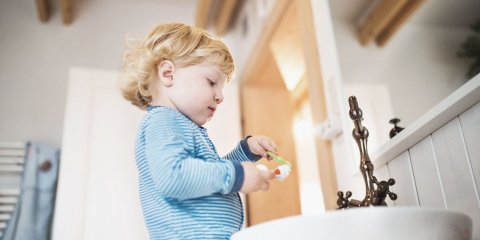Key Points
- Dental decay is a significant health concern for Australian children
- An adequate brushing regimen and an appropriate toothpaste for toddlers is vital
- Generally, toddlers from 18 months should use a pea-sized amount of low-fluoride toothpaste
- In rural areas without fluoridated water, standard toothpaste may be recommended for toddlers
- The risk of using or swallowing too much fluoride is dental fluorosis
How can you best care for your toddler’s teeth? How do you know which toothpaste and how much of it you should use? We break down all there is to know about brushing routines and toothpaste for toddlers, so you can keep enjoying those cheeky grins!
Teeth cleaning for toddlers: the basics
A good teeth cleaning routine from 12-18 months looks like this :
- Brush twice per day for two minutes, in the morning and before bed
- Use water only at this age
- Use an age-appropriate toothbrush (eg. for children under two) which is small and quite soft

A good teeth cleaning routine from 18 months on , looks like this:
- Brush twice per day for two minutes, in the morning and before bed
- Use a pea-sized amount of low-fluoride toothpaste (400-550ppm) and encourage your toddler to spit it out, without rinsing.
- Use an age-appropriate toothbrush (eg. for children under two, or 2-5) which is small and quite soft
These are the recommendations provided, but it’s important to understand why they are in place, and whether your toddler’s situation may deviate from these recommendations.
The prevalence of dental decay in children
Unfortunately, dental decay is quite common in children. A 2009 Australian survey found 51% of 6-year-old children attending a school dental service had decay in one or more baby teeth. In this instance, decay also means missing or filled teeth.
Dental decay was relatively common among Australian children who attended a school dental service.
The survey identified five factors with a significant influence as to whether dental decay will occur .
- frequency of carbohydrate intake , which allows bacteria in the plaque to produce concentrations of organic acids that can dissolve the tooth
- accumulation and retention of plaque , a potential breeding ground for acid-producing bacteria
- frequency of exposure to dietary acids in addition to the bacterial acids
- exposure to fluoride and some other trace elements, which help control the development of decay
- natural protective factors such as saliva, which may help prevent or limit the progress of decay.”
These five factors that influence the formation of decay can be summarised by three behavioural risk factors:
- Substandard tooth cleaning
- Poor diet
- Limited exposure to fluoride
Plaque is reduced by tooth brushing and/or use of a product that can kill acid-causing bacteria. Therefore, two of the three behavioural risk factors above can be addressed with an adequate brushing regimen.
Behavioural impacts on toddler dental health
There are a lot of reasons why your toddler’s brushing regimen may be less than desirable. Not having the right information means the foundation just isn’t there. But, behaviourally, there can be some issues too.
Firstly, when it comes to night-time brushing and how this interplays with putting our little ones to sleep.

Here’s one relatable scenario: You may have struggled with getting your toddler to sleep in the past, but have been having more success lately. Your bedtime routine might involve giving them a bottle as their very last step before bed. You might also send your child to bed with a bottle.
It’s understandable that you don’t want to rock the boat at this point, when you’re all finally getting some sleep, but having that bottle after brushing is not ideal for healthy teeth, because it allows the milk or formula to remain on the teeth overnight.
Secondly, there might be an issue of cooperation with your toddler.
At the end of a long and busy day, you’re tired. It’s all too easy to throw in the towel when your little one flat-out refuses to have their teeth brushed. But, you must persevere, and we’ll give you some tips later in the article to help persuade them.
If they insist on brushing their teeth themselves, this is better than nothing. But they won’t be able to do a thorough job without your help. From two years, your child can help to clean their teeth - with supervision and assistance!
Now that we’ve addressed the problem of dental decay, let’s look at concerns with choosing a toothpaste for your toddler.
Toothpaste for toddlers: the concerns
Fluorosis
Fluoride is what prevents dental caries (decay) from forming. So the need for its use is obviously important. But this must be carefully balanced in children under 6 years of age with the risk of dental fluorosis .
What is dental fluorosis?
“ Dental fluorosis is a developmental disturbance of dental enamel .” So even before teeth appear, they are being affected by exposure to fluoride. Too much exposure causes demineralisation of the tooth enamel, often visible as white streaks or frosted edges on teeth.
Subsequently teeth can pit, stain and become more porous. It’s important to point out that enamel fluorosis is permanent .
It has been found that “changes in permanent dentition … are more prone to occur in children who are excessively exposed to fluoride between 20 and 30 months of age .” But overall, the most critical period for avoiding overexposure to fluoride is between the ages of one and four .
In regions of Australia where the mains water is already fluoridated, children can easily be overexposed if they use toothpaste which has too much fluoride in it, or even just too much low-fluoride toothpaste.
And although dental health starts young, it has been found that before 18-24 months, using toothpaste containing fluoride does not provide the extra benefits of preventing decay. That’s why only water is recommended up to 18 months of age.
Swallowing reflex
Another risk factor for fluorosis occurring is swallowing too much of it. Young children have a stronger swallowing reflex, which makes it more likely they will swallow the toothpaste in their mouths.
In fact, approximately 50% of toothpaste is swallowed when three and four-year-olds brush their teeth . That’s why toddlers should be encouraged to spit out their toothpaste . Adding water to rinse only tends to increase the amount of toothpaste they swallow.
As well as assisting with the actual brushing of teeth, this is another reason why parents should always supervise their toddlers when cleaning their teeth.
When the recommendations on toothpaste for toddlers may not apply
We have discussed some sound recommendations for brushing your toddler’s teeth. But there may be reasons why these may not apply to your family.
Some regions of Australia (usually rural) do not have fluoridated water. As we’ve mentioned already, some fluoride is necessary from 18 months, or at the latest, two years of age, to help prevent dental caries. Without fluoride in the mains water, toddlers living in these areas may benefit from using a standard toothpaste (1,000-1,500ppm), rather than a low-fluoride one. This is particularly true if those children are already at a higher risk of dental decay .
In fact, a Victorian study found that, for toddlers in their second year of life who live in areas without fluoridated water, promoting early exposure of fluoride in toothpaste may be successful at reducing dental caries .
Of utmost importance is seeking the advice of your local dentist when choosing toothpaste for toddlers.
Tips for brushing your toddler’s teeth
Once you understand what your toddler’s teeth-brushing routine should look like, you may run into one more hurdle - getting them to cooperate. Here are some tips to persuade them to let you look after their pearly whites:
Let them help choose their toothbrush.
If they love their toothbrush (whether it’s the colour, shape or features a favourite character), they’ll be happier to have their teeth brushed.
Sing to your toddler while brushing
Many parents find singing to their child helps them through all manner of situations! Teeth-brushing is the perfect example of distracting your child from something they’d rather not do, with song.
You can use their favourite song of the moment, make up your own song, or use the tried and true:
This is the way we brush our teeth,
brush our teeth, brush our teeth,
This is the way we brush our teeth,
early in the morning/early in the evening.
Take turns
This is an important part of toddlerhood - learning to take turns.
You can let them have a turn at brushing your teeth, before it’s your turn to brush theirs. Or, encourage them to “brush the teeth” of their favourite stuffed animal or doll.
Read books about brushing
Toddlers don’t understand why you’re always trying to brush their teeth, especially when it becomes stressful and you’re just trying to get it over and done with in a hurry. It can help a lot to read them books about teeth-brushing, normalising it so they understand why it’s a part of everyday life.
The bottom line is that brushing your toddler’s teeth well, right from the beginning is so important to their future dental health. Choose the right toothpaste and toothbrush for them, establish a good brushing routine, get them happy about brushing, and you’ll be able to keep enjoying those cheeky grins for a long time to come!

